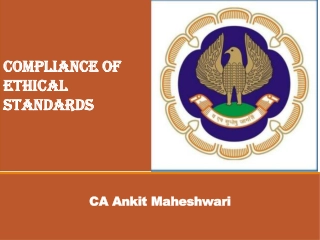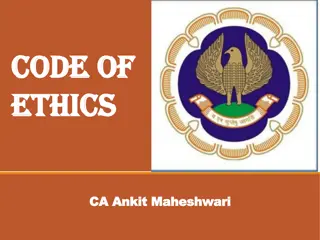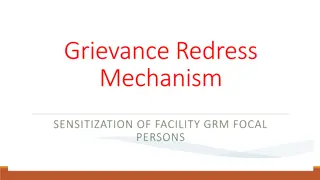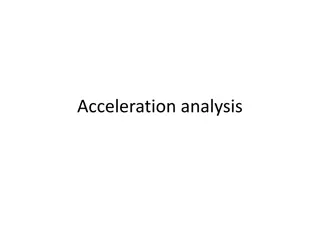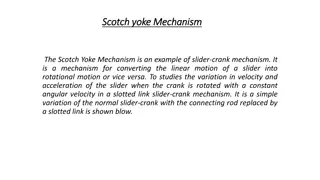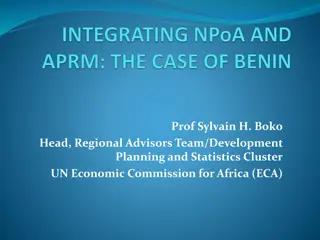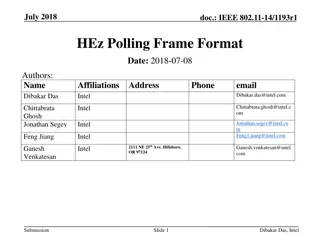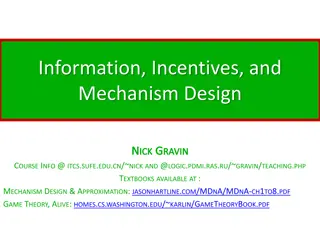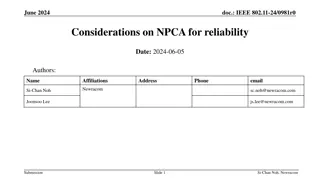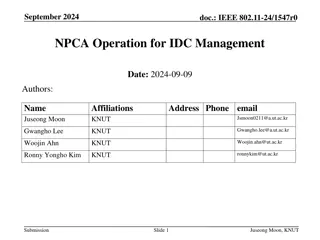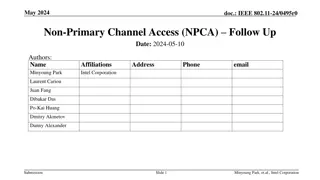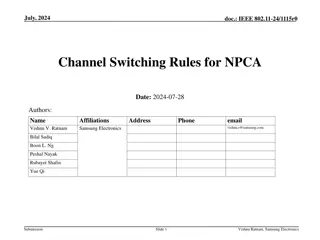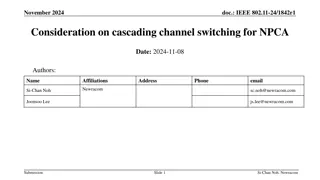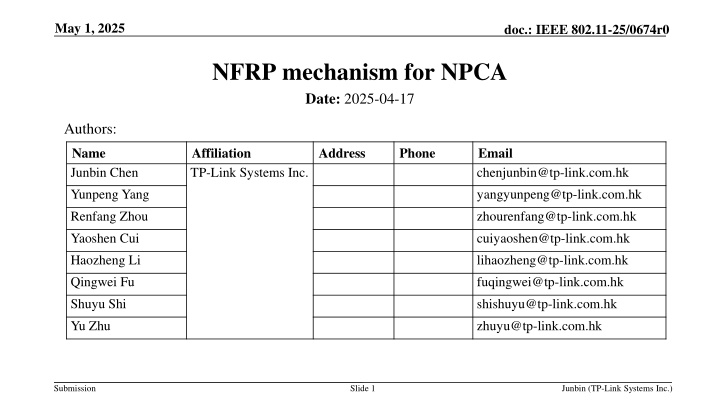
Enhancing NPCA Mechanism for Improved WLAN Performance
Explore a proposed mechanism to address hidden node issues in NPCA for IEEE 802.11 networks, focusing on optimizing UL low-latency traffic and channel access protocols. Learn about utilizing ICF/ICR and exploring new methods like MU-RTS/CTS for enhanced communication efficiency.
Download Presentation

Please find below an Image/Link to download the presentation.
The content on the website is provided AS IS for your information and personal use only. It may not be sold, licensed, or shared on other websites without obtaining consent from the author. If you encounter any issues during the download, it is possible that the publisher has removed the file from their server.
You are allowed to download the files provided on this website for personal or commercial use, subject to the condition that they are used lawfully. All files are the property of their respective owners.
The content on the website is provided AS IS for your information and personal use only. It may not be sold, licensed, or shared on other websites without obtaining consent from the author.
E N D
Presentation Transcript
May 1, 2025 doc.: IEEE 802.11-25/0674r0 NFRP mechanism for NPCA Date: 2025-04-17 Authors: Name Junbin Chen Yunpeng Yang Renfang Zhou Yaoshen Cui Haozheng Li Qingwei Fu Shuyu Shi Yu Zhu Affiliation TP-Link Systems Inc. Address Phone Email chenjunbin@tp-link.com.hk yangyunpeng@tp-link.com.hk zhourenfang@tp-link.com.hk cuiyaoshen@tp-link.com.hk lihaozheng@tp-link.com.hk fuqingwei@tp-link.com.hk shishuyu@tp-link.com.hk zhuyu@tp-link.com.hk Submission Slide 1 Junbin (TP-Link Systems Inc.)
May 1, 2025 doc.: IEEE 802.11-25/0674r0 Abstract Currently, we have define that the NPCA STA may switch to the NPCA primary channel when the primary channel is occupied by OBSS transmissions [1-2]: However, the hidden node may lead to mismatch problem of the parking channel between AP and STAs [3-4]. The AP hears OBSS PPDU and switch to NPCH, but STA stays on the PCH; and vice versa. Besides, many previous contributions [4-6] suggest to disable the untriggered UL transmission in NPCH. Thus, we shall define a mechanism for non-AP STAs to report their buffer status of UL low-latency traffic. In this presentation, we d like to mitigate the problems mentioned above by extending the NFRP mechanism for NPCA. Submission Slide 2 Junbin (TP-Link Systems Inc.)
May 1, 2025 doc.: IEEE 802.11-25/0674r0 Recap: hidden node issues in NPCA A general solution: The AP send an ICF soliciting ICR in order to query for the channel status of STAs. The non-AP STA reports that it stays on PCH or it has switched to NPCH. Case 1 OBSS activity is hidden to AP Bandwidth assumption: STA1: 80MHz or 40MHz STA2: 40MHz STA3: 80MHz All STAs are NPCA STAs STA2 STA2 STA1 STA3 STA1 STA3 Case 2 OBSS activity is hidden to non-AP STA AP AP OBSS AP OBSS AP ICF ICR(STA1/3) ICF ICR(STA1/3) S40 S40 NPCH NPCH ICF ICR(STA1/3) ICF ICR(STA1/3) STA2 stays on PCH and do not respond ICR ICR(STA2/3) ICF OBSS OBSS for AP P40 P40 for STA1 ICF PCH PCH ICR(STA2/3) Submission Slide 3 Junbin (TP-Link Systems Inc.)
May 1, 2025 doc.: IEEE 802.11-25/0674r0 Why not to reuse the (MU-)RTS/CTS as the ICF/ICR? The RTS/CTS works only for SU in the aforementioned scenarios. To query for the channel status of multi-user: The AP shall transmit an MU-RTS, which contains multiple user info field, causing overhead. The indicated STAs respond the MU-RTS with CTS in 20MHz non-HT DUP PPDU. Most importantly, the CTS frame only contains RA but not TA. Therefore, the AP can not distinguish the sender of CTS. MU-RTS(20MHz non-HT DUP) CTS(20MHz non-HT DUP) Frame control Frame control control user info user info user info user info user info user info user info user info user info user info user info user info Mac header Mac header Mac header Mac header Commo n info Commo n info Commo n info Commo n info Frame control Frame Frame control duration duration duration RA RA RA FCS FCS FCS padding FCS 20M STA duration duration RA RA FCS FCS padding FCS 40M STA Frame control Frame control duration RA FCS padding FCS 80M STA duration RA FCS padding FCS Submission Slide 4 Junbin (TP-Link Systems Inc.)
May 1, 2025 doc.: IEEE 802.11-25/0674r0 Why not to reuse the BQRP? In 11ax, the BQR is used to report the availability of each 20MHz subchannel. Advantages: The non-AP STAs can report the detailed availability of each 20MHz subchannel. Disadvantages: As an ICF, the BQRP contains multiple user info field, which brings further overhead. As an ICR, the BQR report shall be transmitted through different RUs as indicated in the BQRP frame from AP. However, the AP is trying to query the channel status so as it can make a proper RU assignment. BQRP BQR in HT control STA 1 user info user info user info user info user info user info user info user info user info user info user info user info Frame control Frame body Mac header Mac header Mac header Mac header Commo n info Commo n info Commo n info Commo n info duration HT Control RA FCS padding FCS STA 2 Frame control Frame control Frame control Frame body Frame body Frame body duration HT Control RA FCS padding FCS STA 3 duration HT Control RA FCS padding FCS duration HT Control RA FCS STA 4 padding FCS Submission Slide 5 Junbin (TP-Link Systems Inc.)
May 1, 2025 doc.: IEEE 802.11-25/0674r0 Recap: NFRP and NDP feedback report The NFRP allows AP to trigger multiple STA for a short feedback. There is only one user info field in NFRP indicating multiple STAs. Query up to 72 users in one NFRP with 80MHz bandwidth (in absence of UL mu-mimo). NDP(HE TB PPDU) NFRP(20MHz non-HT DUP) Phy header STA 1~18 user info user info user info user info L-STF/L-LTF/L-SIG/RL-SIG L-STF/L-LTF/L-SIG/RL-SIG L-STF/L-LTF/L-SIG/RL-SIG Common info PE HE-SIG-A HE-SIG-A HE-SIG-A HE-LTF HE-LTF HE-LTF PE PE PE Phy header Mac header STA 19~36 L-STF/L-LTF/L-SIG/RL-SIG L-STF/L-LTF/L-SIG/RL-SIG L-STF/L-LTF/L-SIG/RL-SIG L-STF/L-LTF/L-SIG/RL-SIG L-STF/L-LTF/L-SIG/RL-SIG Common info PE HE-SIG-A HE-SIG-A HE-SIG-A HE-LTF HE-LTF HE-LTF PE PE PE Phy header Mac header STA 37~54 L-STF/L-LTF/L-SIG/RL-SIG HE-SIG-A HE-SIG-A HE-SIG-A HE-LTF HE-LTF HE-LTF PE PE PE Common info PE Phy header Mac header L-STF/L-LTF/L-SIG/RL-SIG L-STF/L-LTF/L-SIG/RL-SIG L-STF/L-LTF/L-SIG/RL-SIG HE-SIG-A HE-SIG-A HE-SIG-A HE-LTF HE-LTF HE-LTF PE PE PE Common info PE STA 55~72 Phy header Mac header The polled AID range: (Starting AID,Starting AID + ????) where ????= 18 2?? (1 + ???????????? ???????????) Submission Slide 6 Junbin (TP-Link Systems Inc.)
May 1, 2025 doc.: IEEE 802.11-25/0674r0 Proposal: Reuse NFRP/NDP for channel status query We suggest that the NPCH shall be set in the S40/S80/S160. Such NPCH selection leads to a low probability of being occupied by OBSS TXOPs occupying the primary channel. We suggest to reuse the NFRP/NDP to query for the parking channel status of NPCA STAs. We need to define a new feedback type for channel status report. The RU_TONE_SET_INDEX needs to be redesigned. In the baseline, the subcarriers of 80MHz bandwidth are divided into 72 RU_TONE_SET. In the proposal, the subcarriers in RU_TONE_SET 37~72 are merged into the RU_TONE_SET 1~36, respectively. baseline RU_TONE_ SET_INDEX 1~18 RU_TONE_ SET_INDEX 37~54 RU_TONE_ SET_INDEX 55~72 RU_TONE_ SET_INDEX 19~36 frequency proposal RU_TONE_ SET_INDEX 1~18 RU_TONE_ SET_INDEX 1~18 RU_TONE_ SET_INDEX 19~36 RU_TONE_ SET_INDEX 19~36 Submission Slide 7 Junbin (TP-Link Systems Inc.)
May 1, 2025 doc.: IEEE 802.11-25/0674r0 The transmission of NDP feedback report The non-AP STA determines to transmit NDP as follows: The assigned RU_TONE_SET contains 24 subcarriers, which can be divided into 4 groups: 1st and 2nd group located in P40, 3rd and 4th group located in S40. P20 (user 1~18) S20 (user 19~36) S40_L20 (user 1~18) S40_H20 (user 19~36) frequency P40 S40 RU_TONE_SET_INDEX c: RU_TONE_SET_INDEX a: RU_TONE_SET_INDEX b: RU_TONE_SET_INDEX d: The NDP feedback report shall be transmitted through the 1st and 2nd group if the non-AP STA stays on the PCH; shall be transmitted through the 3rd and 4th group if the non-AP STA has switched to the NPCH shall be transmitted through all the 1st/2nd/3rd/4th group if the non-AP STA determines that both PCH and NPCH are idle. Further, the non-AP STA determines whether it has pending low-latency UL traffic: If yes, the HE-LTF field shall be non-zero in 1st and/or 3rd group, and shall be all zero in 2nd and/or 4th group. If no, the HE-LTF field shall be all zero in 1st and/or 3rd group, and shall be non-zero in 2nd and/or 4th group. 1st 2nd 3rd 4th Submission Slide 8 Junbin (TP-Link Systems Inc.)
May 1, 2025 doc.: IEEE 802.11-25/0674r0 Example of detection algorithm in AP side In AP side, the feedback can be determined based on the power detection [8]. The power detection is performed on P40 and S40 respectively. P1 = sum(power in 1st group subcarriers); P2 = sum(power in 2st group subcarriers); Not(P1 > K*P2) & Not(P2 > K*P1) PCH_No_Response P1 > K*P2 P2 > K*P1 PCH_LL PCH_NL P3 > K*P4 P4 > K*P3 Not(P3 > K*P4) & Not(P4 > K*P3) NPCH_No_Response NPCH_LL NPCH_NL P3 = sum(power in 3rd group subcarriers); P4 = sum(power in 4th group subcarriers); PCH_LL PCH_NL PCH_No_Response NPCH_LL PCH: idle; NPCH: idle; Pending LL data: Yes Unreliable feedback PCH: busy; NPCH: idle; Pending LL data: Yes NPCH_NL Unreliable feedback PCH: idle; NPCH: idle; Pending LL data: No PCH: busy; NPCH: idle; Pending LL data: No NPCH_No_Response PCH: idle; NPCH: busy; Pending LL data: Yes PCH: idle; NPCH: busy; Pending LL data: No PCH: busy; NPCH: busy; Submission Slide 9 Junbin (TP-Link Systems Inc.)
May 1, 2025 doc.: IEEE 802.11-25/0674r0 Summary In this presentation, we propose to extend the existing NFRP/NDP mechanism for NPCA. The NDP feedback can be reused to query for the parking channel of non-AP STAs. Also, the proposed NDP feedback report indicates whether the non-AP STAs are requesting for UL transmission for its buffered low-latency traffic. Submission Slide 10 Junbin (TP-Link Systems Inc.)
May 1, 2025 doc.: IEEE 802.11-25/0674r0 References [1] 24/0209-bn [2] Draft P802.11bn D0.2 [2] 24/0670-bn [3] 24/1125-bn [4] 24/1218-bn [5] 24/1093-bn [6] 24/1155-bn [7] 24/1885-bn [8] 17/0044-ax Specification Framework for TGbn, Ross Jian Yu (Huawei) Different view problems of NPCA, Sanghyun Kim (WILUS) Considerations on switching for NPCA, Dongju Cha (LG Electronics) NPCA - next level discussions, Gaurang Naik (Qualcomm) Special scenarios in Non-Primary Channel Access, Sindhu Verma (Broadcom) Further discussions on NPCA, Sanghyun Kim (WILUS) NPCA Hidden Node Problem, Gwangho Lee, (KNUT) NDP Short Feedback Design, Leo Montreuil (Broadcom) Submission Slide 11 Junbin (TP-Link Systems Inc.)

